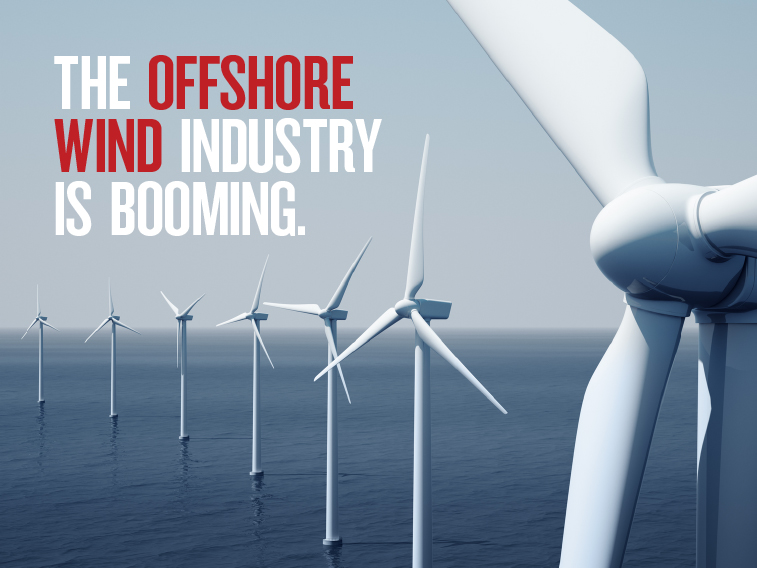On a seasonally adjusted basis, the NAB Online Retail Sales Index recorded a drop in growth in July


Insight
The offshore wind industry is booming, with 22GW of installed capacity worldwide and the first project planned for Australia.

Flying in to London from continental Europe, a striking sight that often greets visitors out of the window of the plane is offshore wind turbines churning out power for the homes and businesses of south east England. The wind farms in this part of the UK tend to be earlier projects — commissioned between 2010-2012, they typically employ 3 – 3.6MW turbines in water depths up to 30m and are located between 10-25km from shore.
Testament to the rapid growth and maturity of the sector, projects currently in development and construction are up to 3.6GW in size, utilising 9.5 – 12MW turbines in water depths up to 50m and located up to 130km from shore. This is truly large-scale electricity generation infrastructure.
Borne out of the offshore oil and gas industry, the first offshore wind project (Vindeby) was 5MW and was commissioned in Denmark in 1991. Now, 28 years on there is 22GW of offshore wind capacity installed globally¹ (c.83% of which is in Europe), with a further 90GW or more forecast to be installed by 2030². The distinguishing characteristics of offshore wind that appeal to governments and developers include higher capacity factors (often 50-60%) compared to onshore wind and solar, the ability to deploy at scale and being less susceptible to NIMBY-ism, and continuing innovation in technology such as larger turbines.
The largest market in Europe is the UK, followed by Germany, Denmark, the Netherlands and Belgium, with development activity now also starting to gather momentum in France and Poland. Industry growth in the UK and elsewhere has been driven initially by subsidies that have de-risked cashflows. As the industry supply chain has matured, technology has become larger and more efficient and capital providers have become more comfortable with the risks, costs have come down dramatically, reflected in the reduction of UK CfD auction clearing prices from £114/MWh (2012£) in 2015 to £39/MWh (2012£) in the 2019 auction recently announced. At these levels CfDs become price stabilisation mechanisms rather than “subsidies” per se. Indeed, the International Energy Agency predicted in an October 2019 report that costs will fall by 40% and offshore wind could be the single largest source of power generation in Europe by 2040³.
This industry success has bought with it great rewards:
• for governments, the opportunity to procure renewable power at scale in a cost-effective manner;
• for project developers and contractors, the visibility of a sustainable future for the industry, enabling them to invest in technology, development and capability;
• for investors, the opportunity to meet ESG objectives through investment in large scale energy infrastructure with stable cashflows.
Looking ahead, however, challenges for the industry are evident: continued pressure on costs across
the supply chain in an effort to improve chances of success in auctions for subsidies and/or development rights; renegotiation of tariffs awarded reflecting cost declines; building capability in supply chains in new markets where governments often require minimum levels of local content; project economics creating the need to source large scale corporate Power Purchase Agreements to provide some price stabilisation.
The offshore wind industry is set for continued strong growth in the coming years as decarbonisation of the power sector and the broader economy picks up pace globally.
With such significant reduction in costs and an increasingly clear imperative to accelerate the energy transition it was inevitable that the offshore wind industry would grow beyond Europe into new markets. China is anticipated to be the highest growth market in the coming years, forecast to overtake the UK with the largest installed capacity by 2023, although currently few international firms are present. Other markets with active late-stage development or construction projects are the east coast of the US and Taiwan, with Korea and Japan following.
In Australia, the first proposed offshore wind farm in development is a very large 2GW project off the south coast of Gippsland, Victoria known as Star of the South. The project is being developed by its Australian founders and Copenhagen Infrastructure Partners, an experienced offshore wind investor in Europe. They cite advantages such as greater wind speeds and strength than onshore wind, meaning offshore wind farms can produce more electricity, more consistently.
Unlike many European countries, Australia is not land constrained and has strong onshore wind resources, so there has not been a pressing need to build offshore. Star of the South would need to deliver electricity at a lower cost than the current A$50-60 MWh cost of onshore wind — which seemed unlikely until the recent sharp decline in UK CfD auction prices to A$784 suggesting the cost gap is narrowing.
There’s also a question as to whether UK CfD costs are directly transferable to Australia, where there is no established supply chain and a smaller end market. One area where Star of the South might have an advantage is cost to the grid, as it would connect into the pre- existing Latrobe Valley transmission infrastructure which over time will have more capacity as coal continues to retire. It’s certainly a project to watch.
This article was originally published in 2020 Outlook: Creating Opportunities- read the full magazine or download this article.
¹ Clarksons Research
² Bloomberg New Energy Finance
³ https://www.iea.org/offshorewind2019/
4 £39/MWh (2012£) in the 2019 auction, adjusted for inflation to £43 in current pounds.
Speak to a specialist© National Australia Bank Limited. ABN 12 004 044 937 AFSL and Australian Credit Licence 230686.